Traditional Revenue Streams in the Music Industry: Stepping into the music industry can feel akin to venturing into an intricate labyrinth. It’s an enigmatic world filled with winding paths of different revenue streams, some traditional, some digital. If you’re a newcomer, it might seem impossible to decipher, but fear not. This comprehensive guide aims to illuminate the various ways new music artists can generate income in today’s ever-evolving music landscape.
Live Performances: The Bread and Butter of New Artists
Most, if not all, music artists kickstart their journey with live performances. Whether it’s an intimate gig at a local bar or a vibrant music festival, live performances provide a platform for artists to display their talent and connect with their audience. Moreover, these gigs serve as a crucial revenue stream. You might start with just a handful of listeners and a modest performance fee, but remember, success isn’t instant. It’s about consistently delivering captivating performances, nurturing your fan base, and honing your stagecraft. With time, popularity grows, and so does the paycheck.
Record Sales: Then and Now
The digital revolution may have transformed the music industry, but selling physical copies of music still has its place. Vinyl records, for instance, have seen a resurgence in recent years. Collectors, music enthusiasts, and dedicated fans often value these tangible forms of music and are willing to pay a premium for them. So, if you’re a new artist, don’t overlook this old-school approach. It could add a unique flavor to your revenue mix.
Radio Airplay: Still Relevant?
In the age of streaming and digital downloads, one might wonder if radio airplay is still a viable source of income. The answer is a resounding yes. Every time a song is played on the radio, the artists, songwriters, and producers earn royalties. Consequently, creating radio-friendly tracks that appeal to the masses can lead to a steady stream of income. If your song becomes a breakout hit, it can turn into a veritable cash cow.
Digital Shift: Revenue Streams in the Music Industry in the 21st Century
Streaming Services: A Double-Edged Sword?
Streaming platforms like Spotify, Apple Music, and Tidal have revolutionized how we consume music. With millions of songs at our fingertips, these platforms offer artists exposure to millions of listeners worldwide. However, the royalty rates can often seem minuscule, causing some artists to question their value. But don’t let initial low earnings discourage you. As you garner more listeners and grow your fan base, the cumulative effect of streams can become a substantial revenue source through revenue streams in the music industry.
Digital Sales: Buying Music in Bits and Bytes
Even as streaming services dominate the music consumption landscape, digital sales remain a viable revenue stream. Selling music online, whether as singles or albums, through platforms like iTunes or Bandcamp, allows artists to earn money per sale, usually at a higher rate than streaming services. Moreover, owning digital copies of songs still holds appeal for many music lovers, especially for tracks they want to replay without the limitations of a data connection.
Online Radio: Pandora’s Box of Opportunities
Online radio platforms like Pandora and iHeartRadio have disrupted traditional radio broadcasting,
offering personalized listening experiences to users. For artists, these platforms present another avenue to reach potential fans and earn royalties. Much like traditional radio, online radio platforms pay artists for every play, offering an additional revenue streams in the music industry. that’s worth exploring.
Beyond the Music: The Rise of Merchandising
Apparel and Accessories: Wearing the Music
A band T-shirt isn’t just a piece of clothing; it’s a statement. Music merchandise, such as T-shirts, hats, and posters, is a fantastic way for artists to monetize their brand beyond their music. This approach is about creating a brand identity that fans want to associate with and publicly show their allegiance to. As such, investing time in creating appealing, high-quality merchandise can lead to a lucrative sideline.
Limited Edition Releases: The Allure of Exclusivity
In an age of mass production, exclusivity holds immense appeal. Limited edition releases, whether they are vinyl records, merchandise, or special edition albums, can generate a buzz around your music and fetch high prices due to their rarity. For new artists, this strategy can lead to a significant revenue boost, particularly when timed with album releases or tours. It also provides an opportunity to express creativity and connect with fans on a deeper level.
Conclusion of Revenue Streams in the Music Industry
While this article does not encompass every possible revenue stream for new music artists, it serves as a solid foundation for understanding the complex financial landscape of the music industry. Remember that music isn’t just an art; it’s also a business. Success in this industry relies not only on your talent but also on your marketing skills and business acumen. It’s not just about creating great music; it’s about effectively monetizing your artistry to sustain, grow your music career and make profitable music career. Your melody to success will require crafting a harmonious blend of creativity and strategic financial planning.
FAQs Related to Revenue Streams in the Music Industry
Q1 Are live performances still a viable revenue source for new artists?
Ans: Yes, live performances are often the primary source of income for new artists. They provide a platform to showcase talent, connect with fans, and earn money.
Q2 How can new artists make money from revenue streams in the music industry services?
Ans: Although individual streams pay small amounts, a high volume of streams across various platforms can generate substantial revenue. As an artist’s popularity and fan base grow, so too can their earnings from streaming.
Q3 Can selling physical copies of music still be profitable?
Ans: Absolutely. There’s a niche market for physical forms of music, such as vinyl records, among collectors and dedicated fans. These can be a valuable addition to an artist’s revenue streams.
Q4 What is the role of merchandise in an artist’s revenue stream?
Ans: Merchandise allows artists to monetize their brand beyond their music. Items like apparel and accessories can provide substantial additional income and strengthen an artist’s connection with their fans.
Q5 How can artists maximize their revenue from digital sales?
Ans: Artists can maximize digital sales by leveraging multiple platforms, pricing their music strategically, and using effective marketing strategies to promote their music and reach a broader audience.
Our Reader’s Queries
What are the revenue streams in the music industry?
In the past two decades, streaming has become the dominant force in the music industry. As of 2022, digital music revenues accounted for a staggering 89% of the industry’s total revenue in the United States. The lion’s share of this revenue, a whopping 84%, came from popular streaming services such as Spotify, Amazon Music, and Apple Music. It’s clear that the way we consume music has changed dramatically, and streaming is now the go-to method for most music lovers.
What generates the most revenue for the music industry?
According to the International Federation of the Phonographic Industry (IFPI), the revenue generated by music streaming has exceeded $17 billion per year. This revenue has been consistently increasing since the mid-2000s, with a growth rate of around 34 times between 2010 and 2020, from $0.4 billion to $13.6 billion. As of 2022, the revenue from music streaming has reached approximately $17.5 billion.
What is the revenue of the music industry streaming?
Despite fans already contributing to the majority of revenues in the music industry, record labels, streaming companies, and media giants are constantly seeking new ways to generate additional income. Unfortunately, these methods often involve disempowering the very fans who make the industry thrive.


